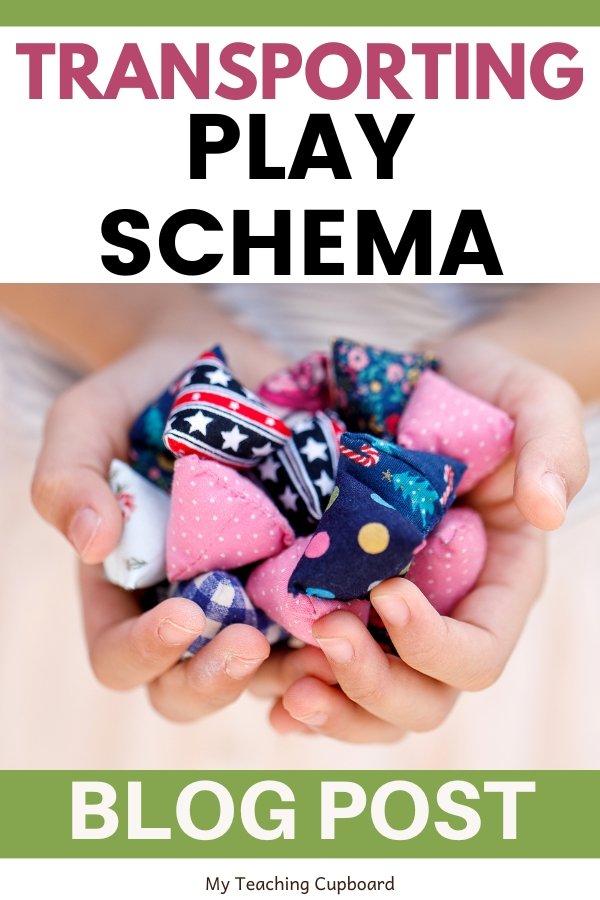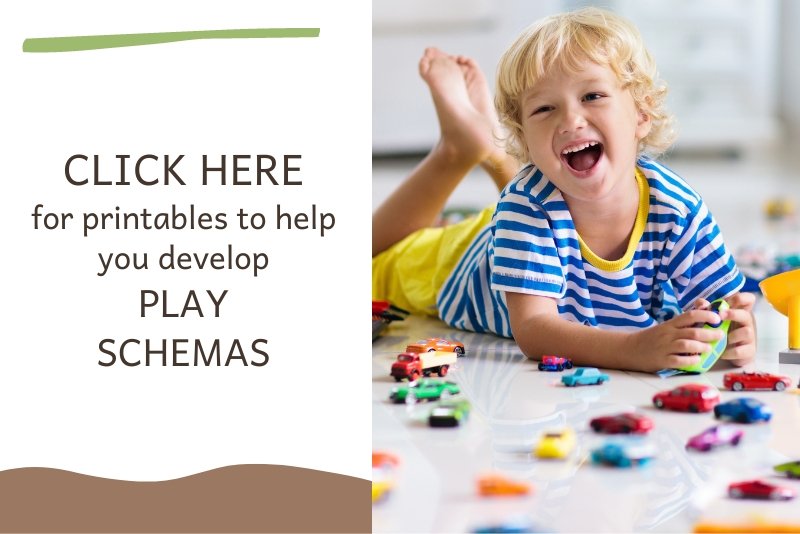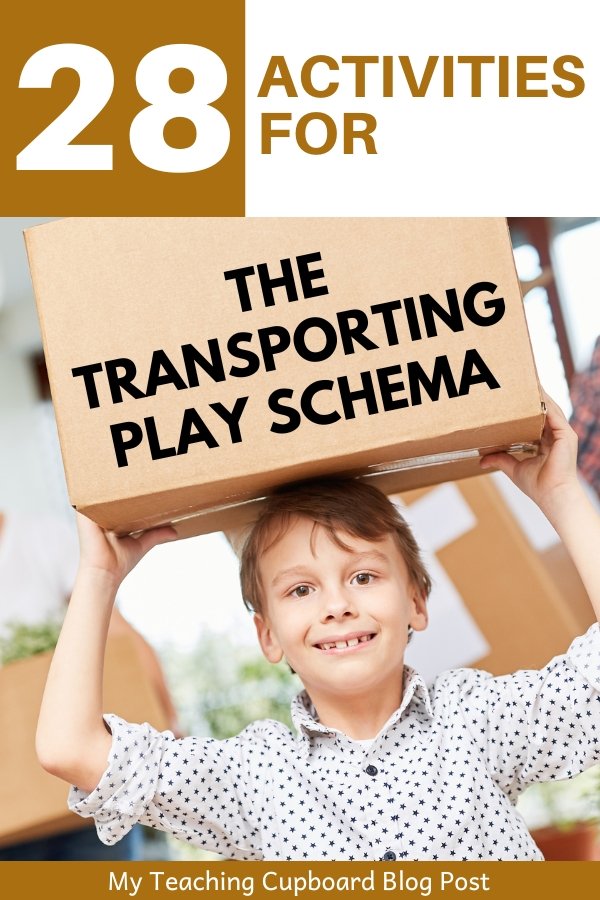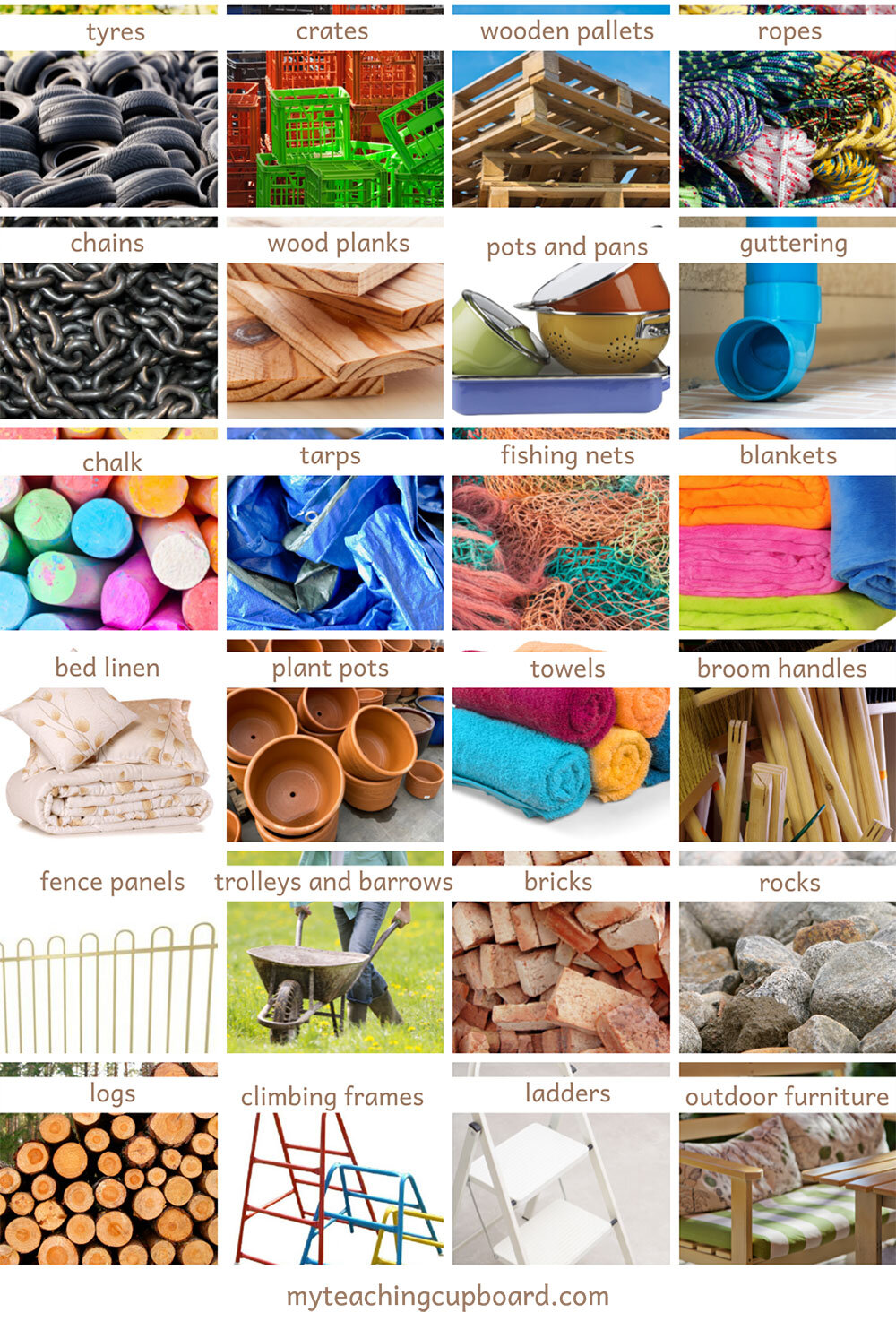The Transporting Schema
The Transporting Schema is a common play schema often observed in kindergarten and preschool classrooms. If you have children interested in moving objects or themselves from one place to another, you have children with a transporting play schema.
All early childhood teachers know how powerful play is for their student’s learning and development. Understanding the different types of play schemas is the key to implementing a play-based learning pedagogy matched to your student’s interests and developmental needs.
Transporting play can lead to numerous learning opportunities. Children will develop spatial awareness, fine motor skills, and problem-solving abilities through the transportation play schema. Are you wondering how to best support this play schema in your classroom?
In this blog post, we will explore the transporting play schema and all its wonderful benefits. You will also discover some of the tried and tested activities I have set up to encourage and facilitate this play schema in my prep and grade one classroom.
So, read on to discover how you can help your little ones transport their way to learning! 😉
What Is a Play Schema?
Play schemas are any repeated patterns of behaviour you might notice your children doing whenever they play. Schemas help children to make sense of their world. Altogether, there are nine play schemas commonly observed in young children.
If you would like to learn more about all of those nine play schemas, make sure you read this blog post: A Guide to Play Schemas in Early Childhood Education
My guide to the nine play schemas explains in more detail what they are and tells you how to use them to teach the curriculum through an age-appropriate and child-led pedagogy.
Schematic play in the classroom relates to how your students investigate and explore the learning resources. It isn’t a specific type of play like dramatic play or sensory play. You can observe play schemas in all of your investigation areas.
If you are looking for an example of the transporting play schema, keep your eye out for any children moving objects or themselves around your classroom. You might notice a child filling up baskets with loose parts and then taking them somewhere else in the classroom. This same child might be pushing their friend around in a pram from the home corner.
You might think these behaviours aren’t related and are different forms of play, but they are both examples of the transporting play schema.
Once you’ve observed a child displaying a specific play schema, you will very often notice the child repeating that same action schematically using various objects and, very often, their own bodies too.
Why Are Play Schemas Important in a Play Based Classroom?
So why are schemas important in early years education? Understanding play schemas and pinpointing the ones your students are developing is critical to the success of your early childhood classroom.
When you understand play schemas you
Better understand your students and their developmental needs.
Broaden your understanding of how children learn.
Tap into your student’s interests and create a child led curriculum.
Increase student engagement.
Know how to encourage your students to become more curious.
Deepen the learning and the intensity of their investigative play sessions.
Make the right observations that inform your planning.
Be able to easily differentiate the learning experiences you offer your students.
You have probably already noticed that not every child in your classroom enjoys the same types of activities. Have you ever set up an amazing learning provocation only to have it ignored or unexplored by your students? Before I knew about play schemas, this happened to me!
Now I understand play schemas, it’s easy to tailor my investigation areas and classroom activities to the developmental needs of my students. Engagement increases when you use your knowledge of play schemas to inform your play-based learning planning and implementation.
You observe and document the learning that is happening in your classroom in a different way when you are aware of early childhood play schemas. You’ll also become more attuned to making the right observations that will help you differentiate and adapt the curriculum to suit the individual needs of your students.
Planning purposeful learning experiences is a breeze when you use your observations and knowledge of play schemas. Schema play can give us extremely valuable insights into children’s passions, interests, and developmental needs.
Understanding play schemas can also help you understand what can sometimes be seen as an undesirable classroom behaviour. For example, you might have a child obsessed with stacking the books in the library area and carting them over to your dramatic play area. I’ve had a child doing this. They repeated this behaviour every investigation session for a week! It was pretty annoying for the children trying to read and for the ones playing in home corner too.
This behaviour might be seen as undesirable, but when you understand that it comes from a child exploring the transporting play schema, you can set up a learning invitation to accommodate their interests and turn the undesirable behaviour into a desirable one.
When teachers understand why certain behaviours are happening in their classrooms, they quickly discover children do not simply misbehave. There’s always a reason for desirable and undesirable behaviours and often, play schemas are that reason.
If you are interested in following the child or a child-led pedagogy, your classroom observations and documentation of play schemas can inform your curriculum planning. Understanding your students’ play schemas helps you design classroom learning experiences to reflect their needs and interests. When you do this, you’ll create a thoughtfully prepared learning environment customized to your students.
Recognising and understanding schemas in play is crucial to the success of any play-based classroom.
What is The Transporting Schema?
Do you have children carrying objects from one place to another or moving things around the classroom?
These are the children developing transporting schemas.
Children with this play schema move or transport objects around and often do it repeatedly. They might use buckets or a wheelbarrow to carry things around, and you might even see them collecting things and dumping them in a pile somewhere.
Children exploring the transporting play schema are also fascinated with how their body can be moved and transported too.
What Are Children Using the Transportation Play Schema Learning?
These children are learning about where things belong. They are building concepts of distance and journeys. They love to map out their environment.
Children exploring their transporting play schema are developing concepts about
journeys
distance
where things belong
They are also learning about object permanence. Object permanence is the understanding that objects continue to exist even when they are out of sight. As children develop their understanding of object permanence, they start to become interested in moving objects from place to place. They start to understand that objects can be transported and still exist.
These children also learn about conservation and how quantities remain the same whether spread out, joined together, or dumped into a container. For example, if a child moves a group of blocks from one side of the room to the other, they learn that the number of blocks remains the same even though their location and arrangement have changed.
Your little learners are developing numerous other math concepts related to shapes, space, measurement, and volume. As they explore the transportation play schema, they will be:
Developing fine and gross motor skills.
Exploring object permanence.
Learning about cause and effect.
Developing visual tracking skills.
Fine-tuning their spatial awareness.
Using their senses to make scientific observations.
Developing creative and critical thinking skills.
Building science and math skills like predicting, estimating, problem-solving, and measuring.
What Vocabulary Supports the Transporting Schema?
under, over, in, on, around
empty, full, half full/empty, nearly full/empty
overflowing, brimming
inside, outside
open, closed
same, different, more, less, equal
passage, path, forwards, backwards, left, right
move, transport, take, carry, transfer, haul
Managing the Transporting Schema in the Classroom
Because the transporting schema is all about moving objects from place to place, it can cause a lot of headaches in a well-organised classroom where everything has a place.
You will need to find a happy balance between supporting the need of some children to transport and making sure your resources don’t end up in weird and wonderful places all around the classroom.
For example, if your children start transporting sand and water onto the carpeted area, this will cause problems!
It is difficult to be flexible enough to allow lots of transporting, but at the same time, maintaining order in a resource filled learning environment. The only solution I have found is allowing some resources (like loose parts) to be used anywhere in the classroom but having hard and fast rules about all other resources and equipment staying put.
Later on, when children have learnt this basic rule, you can modify and re-negotiate. I’ve had a lot of success in letting my students know that I’m totally fine with resources being moved and used in multiple classroom areas, but to check with me or the Teacher Aide first.
28 Activities to Support a Transporting Schema in a Play Based Classroom
You can support their physical, cognitive, and social-emotional development by providing opportunities for your students to engage in transporting play. Here are some tried and tested hands-on activities that you can use in your classroom to support the transporting play schema.
1. Provide various sizes of baskets, boxes, and containers for children to fill and move around the classroom.
2. Add a wagon to the blocks area. Children will enjoy using blocks of different sizes and shapes to fill the wagon and then transport them around.
3. Provide stacking boxes and nesting toys for children to fill and transport around the classroom. These types of resources are great for teaching concepts of size and volume or capacity.
4. Create a few sensory bins with materials such as sand, water, or rice. Add measuring cups and spoons for children to scoop, measure, and transport. Children can explore volume as they fill the containers with the sensory play base and transport them between the trays.
5. Develop fine motor skills with this fun transporting activity - supply pipettes or syringes with coloured water. You can colour the water with food colouring or paint. Children can squirt the coloured water over all sorts of surfaces.
Outdoors, think about offering this type of messy play activity in the sandpit, on the concrete, onto large rolls of paper pegged onto the fence or around a tree.
Inside the classroom, you can place sheets of paper or card on the top of tables, on the floor, or stuck to a wall. Make sure to place the coloured water on a table set up next to your painting surface so children need to transport the coloured liquid to the painting surface.
6. Set up a dramatic play shop area with props such as shopping carts, shopping bags and baskets for children to move around.
7. Include handbags, purses, backpacks, and suitcases in your dress-up dramatic play or role-play area. Children can use these to transport items around the area and the classroom.
8. Provide trays or bins with loose parts materials such as beads, buttons, or pom poms for children to sort and transport.
9. Create an outdoor obstacle course with tunnels, bridges, and balance beams. Supply small toys like stuffed animals for children to take with them as they move through the obstacles.
10. Provide a variety of balls of different sizes and textures for children to roll and transport in your outdoor space.
11. Supply paper bags for the children to collect natural items like leaves and sticks from the playground. Add them to the collage area or use them to create nature pictures. We always do this activity as part of the Living Things science unit.
12. Create a gardening area with tools and wheelbarrows. Add seeds, plant cuttings, and potted plants for children to transport and care for.
13. Add prams and dolls to your dramatic play home corner. Children with a transporting play schema will love to push them around the classroom.
14. Supply baskets and pet containers for children to transport toy animals around in a dramatic play vet or wildlife hospital.
15. Add buckets, spades, and shovels to your outdoor sandpit for students to fill and move around the area.
16. Add ropes and pulleys to your outdoor play area. Children can lift, and transport water, bark, or sand. Pulleys are fascinating to children interested in transporting materials and ties in well with the science unit on Force and Motion.
17. Many early years learning environments have a water wall. Water play is a wonderful opportunity to support children with the transporting play schema. If you aren’t lucky enough to have a water wall in your setting, you can use gutters and pipes fixed permanently to a wall or fence to create a simple one. You might even like to have the children create one so they can attach them however they like. The children can roll water or balls down them.
If you supply moveable pipes and gutters, the children can create their own paths and courses. This is so much fun for children with the transporting play schema and develops critical thinking and problem-solving skills.
You can also get stands that will hold up gutters, and children can create their own pathways for objects to roll down.
18. Give children interested in this play schema classroom jobs requiring transporting. For example, when books and resources need to be returned or picked up from the library, give this job to students developing their transportation play schema.
19. When investigations have finished, and it’s time to re-set the learning environment, provide children with baskets and containers to help them tidy up. Children with a transporting schema love putting things away. They will jump at the chance to collect books, transport them back to the reading area, or collect loose parts and transport them back to their containers. Tidying up helps students learn that objects have a place, and it also helps them to map out their surroundings.
20. Create a little sensory sand tray with small trucks and diggers. Add letter and number stones for children to transport around the tray.
21. Add trucks to a road mat for children to transport loose parts around on. You can purchase these or make your own. You can draw roads with chalk on the concrete or with a marker on a large sheet of cardboard.
We usually make a box town as part of our geography unit. Adding loose parts and a few small dump trucks to the box town will delight children with a transporting play schema.
22. Spend some time learning about recycling when you teach the Materials science unit. It’s important for children to understand the concept of garbage and where it goes. Recycling and rubbish removal interests children with this play schema because it helps them understand where objects go in the world.
23. Children with a transporting schema love mazes. You can draw large chalk mazes on the concrete outside or develop fine motor skills and spatial awareness with maze worksheets.
24. Add a postal delivery bag to your writing area. Children can use this bag to collect and deliver any handwritten letters and cards they have made.
25. Read the book Amy and Louis by Libby Gleeson. You might like to create a matching small world to encourage story retelling. Children interested in the transporting play schema enjoy books about moving and journeys.
26. When learning about sinking and floating, encourage children to make boats to transport playdough or a certain number of blocks.
27. Provide items like baskets and bowls to a mud kitchen. Children can use them to collect herbs, leaves, sand, and other ingredients from their outdoor environment and transport them back to the mud kitchen. We love our mud kitchen. It has endless opportunities for talking about shape, space, measurement, and number.
28. Create maps when you are learning about locations and paths in maths or when you are teaching the HASS Geography unit.
Want to ignite curiosity and support the transporting play schema? You will love my HASS Geography Teaching Bundle!
If you are looking for a comprehensive Foundation Stage resource that enriches your students' understanding of geography and supports their transporting play schema, this bundle can help you. It has been specifically designed to captivate the interest in Geography and mapping.
There are 10 engaging PowerPoint lessons and a corresponding student Journal. All are carefully aligned with the ACARA—Foundation Level content descriptors from the Geography strand of the Humanities and Social Sciences (HASS) Curriculum.
The visually captivating PowerPoint lessons feature high-quality, real-life photos and interactive elements that are perfect for large screen displays and interactive panels. Here’s an overview of the lessons:
🗺️ Lesson 1: Places have Features - Observe, describe, and record the features of a familiar place. (38 slides)
🗺️ Lesson 2: Maps Show the Features and Location of Places - Locate familiar places on a map. (35 slides)
🗺️ Lesson 3: Representing Features and Location of a Place - Describe and record the features and location of a place. (28 slides)
🗺️ Lesson 4: Exploring the Features and Location of a Local Place - Observe and record the features and location of a local place. (27 slides)
🗺️ Lesson 5: People Live in Special Places - Identify how places and their features are special to people. (27 slides)
🗺️ Lesson 6: People Look After Special Places - Identify how people look after special places. (30 slides)
🗺️ Lesson 7: Exploring Personal or Local Places that are Special - Explore reasons why people think a place is special. (28 slides)
🗺️ Lesson 8: Exploring Points of View about a Special Local Place - Explore points of view about a special local place. (36 slides)
🗺️ Lesson 9: Exploring the Classroom as a Special Place - Identify and describe the features of their classroom and suggest ways to care for it. (36 slides)
🗺️ Lesson 10: Reflecting on Special Places - Revise and reflect on special places and how to care for them. (29 slides)
Transporting Loose Parts
You don’t need a heap of specific transporting schema toys to support your students. Just provide plenty of loose parts for your children to fill containers and transport around the classroom.
Loose parts are such an important part of any play-based learning environment, so you might like to consider having a designated loose parts storage area in your classroom. Whether you have children developing the transporting play schema or any other play schemas, loose parts are necessary.
Loose parts are perfect for collecting, stacking, carrying and dumping. If you are interested in learning more about loose parts, I have a blog post where you can discover what loose parts are and why you need them in your classroom.
Loose parts are just as useful in your outdoor play spaces too. Supply children with sheets and pegs or large crates and boxes that they can use to transport around the outdoor space.
Children will use them to create obstacle courses, cubbies, forts, and all sorts of imaginative play scenarios. Outdoor loose parts are a wonderful resource for children with a transporting schema.
You might want to download my FREE Loose Parts list. There are over 150 loose parts resources on this comprehensive list. There are ideas for both indoor and outdoor loose parts. You will be able to refer to this freebie to help you set up plenty of age appropriate investigation areas and learning invitations your little transporters will love.
Transporting Play Conclusion
Once you know about the transporting play schema and what it looks like in the classroom, you will discover how common it is in the children we teach. Understanding this play schema is going to benefit any early childhood educator.
Next time you notice one of your students demonstrating the transporting play schema in your classroom, you now have plenty of ways to support them.
If you enjoyed this blog post on The Transporting Schema and found some useful ideas here, please consider sharing it.
Just CLICK the sharing box below.👇




















